Are you looking for the right Drata alternative to better manage your GRC workflows?
Drata's AI-native GRC solution helps your team automate compliance, manage risk, and accelerate security reviews.
However, some customers of the platform are not satisfied with its limited range of integrations, how unintuitive the platform is, and its lack of a mobile app.
In this buyer guide, I’ll cover the 10 best Drata alternatives that can help you secure SOC 2, manage policies, track compliance efforts, and ensure regulatory alignment.
TL;DR
- SmartSuite offers the best alternative to Drata with its no-code automation builder, ready-to-use GRC templates, and customizable dynamic dashboards.
- Framework-rich tools like OneTrust and SAI360 are ideal for organizations needing extensive prebuilt frameworks and integrations.
- On the other hand, platforms like IBM OpenPages and ServiceNow GRC can help you leverage AI-driven insights for proactive risk mitigation.
Before we begin, I wanted to go over some of the reasons why some compliance leaders have been looking to make the switch from Drata: ⤵️
Why are some compliance leaders looking to switch from Drata?
The main reasons why some customers have been looking to switch from Drata include its limited range of integrations, lack of a mobile app, and the fact that the tool has not been as intuitive for non-technical users as people expected.
But don’t get me wrong here, I’m not saying that Drata is a bad platform that you should to run from.
Hundreds of satisfied users appreciate the platform’s capabilities to centralize their GRC and assurance into a single platform.
However, some users have been dissatisfied with the solution for several reasons:
#1: Limited range of integrations
The #1 complaint about Drata has been about its limited range of integrations.
A verified user of the platform mentions that Drata’s default integrations can be limited; for example, they haven't been able to connect a vulnerability scanner into the platform.

‘’The default integrations that come with Drata are a bit limited, e.g. we still haven't been able to connect a vulnerability scanner into Drata, as it comes with 14 different options by default and we use none of them. That's always an issue with these integration platforms, but it's not clear to us yet how we could build a manual API integration for this feature.’’ – G2 Review.
#2: The platform is not as intuitive as you’d expect
Next up, users complain on G2 about how hard it has been for them to adopt the platform.
Tech-savvy users might have had it easier, but non-technical users can find the software overwhelming and require support and training.
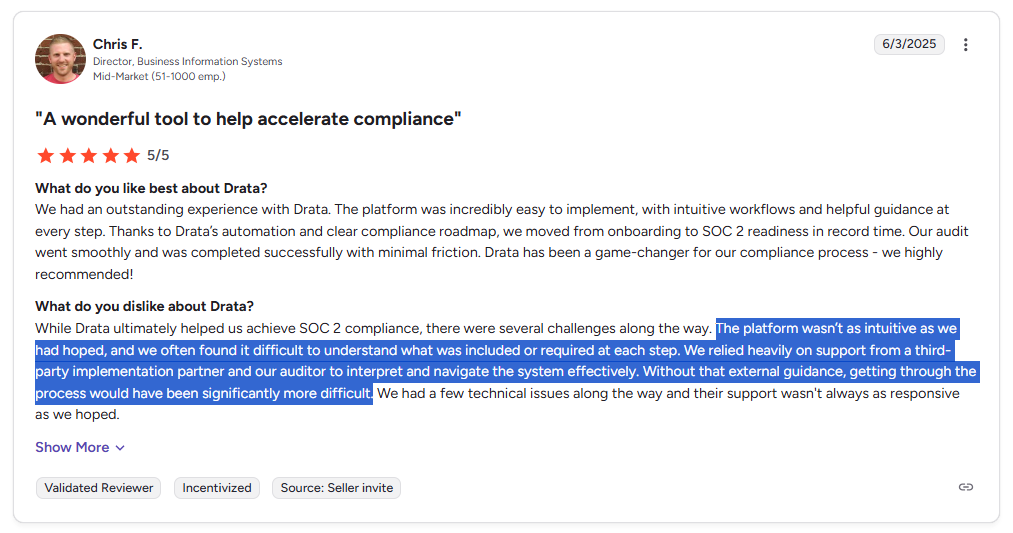
‘’The platform wasn’t as intuitive as we had hoped, and we often found it difficult to understand what was included or required at each step. We relied heavily on support from a third-party implementation partner and our auditor to interpret and navigate the system effectively. Without that external guidance, getting through the process would have been significantly more difficult.’’ – G2 Review.
#3: Lack of a mobile app
Last but not least, users of the tool are not satisfied with Drata’s lack of a mobile app.
A user of the platform mentions that a mobile app would have been a great addition to the tool for on-the-go access.
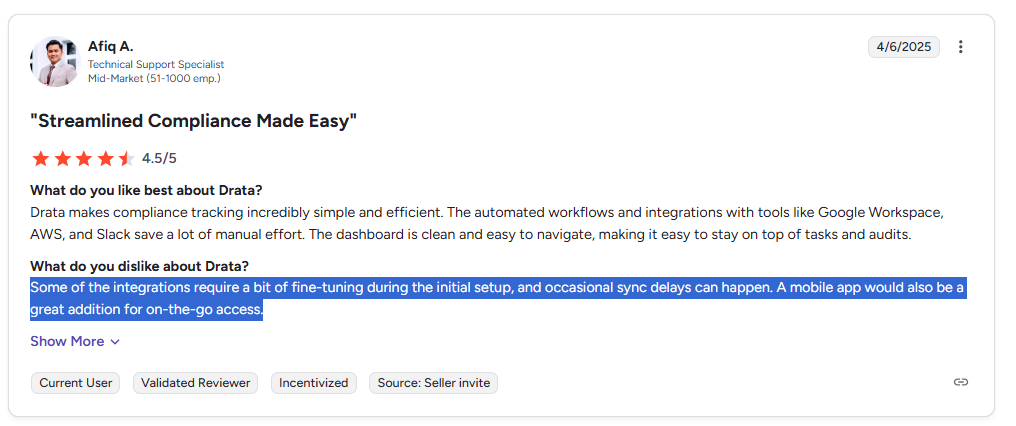
‘’Some of the integrations require a bit of fine-tuning during the initial setup, and occasional sync delays can happen. A mobile app would also be a great addition for on-the-go access.’’ – G2 Review.
What are the best alternatives to Drata on the market in 2026?
Here are the 10 best Drata alternatives for GRC that I shortlisted after evaluating 30+ platforms:
#1: SmartSuite: Best for enterprises looking to launch GRC workflows in days and not months. Our software lets you manage policies, audits, risks, and compliance in a unified, customizable solution.
#2: Hyperproof: Best for companies looking for a scalable, user-friendly platform to streamline compliance, risk, and audit management across multiple frameworks.
#3: Diligent: Best for compliance teams looking for an enterprise-grade GRC solution that brings GRC, audit, ESG, and board management into a single system.
#4: LogicGate: Best for organizations looking for integrated GRC management with real-time risk insights.
#5: SAI360: Best for enterprises looking to unify risk, compliance, and ethics management into one customizable platform.
#6: ArcherIRM: Best for global compliance teams looking to track regulatory developments from all over the world.
#7: AuditBoard: Best for companies looking to uncover GRC insights, track trends, and support data-driven decisions.
#8: OneTrust: Best for organizations looking to automate compliance and gain enterprise-wide visibility into risk associated with technology.
#9: IBM OpenPages: Best for enterprises looking for an AI-powered GRC platform that integrates various risk and compliance functions.
#10: ServiceNow GRC: Best for enterprises looking for integrated risk management and compliance automation.
#1: SmartSuite
SmartSuite offers the best Drata alternative on the market in 2026 with our modern, no-code GRC platform that enables you to simplify complex regulatory requirements.
Our GRC software helps banks and credit unions streamline and automate policy creation, approval, and control assessments, all in one place.

SmartSuite helps you move faster, manage policies smarter, and adapt easily, without having to sign up for multiple training sessions on how to use the platform.
💡 We have recently partnered with the Cyber Risk Institute to deliver a CRI profile for U.S. Banks' compliance needs.
Let’s go over the capabilities that make SmartSuite the best choice for compliance leaders looking to make the switch from Drata: 👇
Comprehensive Governance, Risk & Compliance
Tools like Drata make it so that GRC software can be accessible only to the biggest of companies, with its expensive and complex pricing structure.
However, we believe that compliance should be simple, automated, and accessible to all financial institutions, regardless of their size.
With our no-code, easy-to-use solution, you can automate all GRC processes with a start date next week and not next year.

SmartSuite helps you achieve and maintain compliance without the expense and complexity of adapting legacy GRC solutions like Drata to accommodate new compliance requirements.
Here are the use cases that you’ll get with SmartSuite:
- Create reports and dynamic dashboards: Your team can monitor executive views into your organization's overall risk profile with powerful charting and metrics widgets.

- Collaborate and respond to risks in real-time: You can engage key stakeholders in a real-time discussion of potential threats or vulnerabilities.
Our tool will also provide you with instant updates when critical information becomes available.

- Automate policy creation, real-time approval, and control assessments: Streamline risk management by building an integrated program on a single platform.
- Keep risk and compliance data secure: Define your teams and manage access to information across all GRC practice areas.

- Integrate with your existing systems and data to consolidate and centralize your data.

- Automate for accuracy and efficiency to remove inefficiencies and the chance for human error by automating repeatable workflows.
SmartSuite's no-code automation builder provides you with a visual interface that makes it easy to respond to events and take action.
That means your compliance team can customize your GRC workflows without technical resources.

- Monitor, measure and score: Create risk calculations and metrics to evaluate every aspect of risk.

- Policy management: It’s possible to establish a strong foundation from the get-go with streamlined and flexible policy management.
Your team will be able to assign ownership, manage revisions, and ensure your policies consistently align with key business initiatives and regulatory requirements.

- PSTOS Compliance Tracker: Designed for regulatory compliance and built on SmartSuite.
This solution focuses on data security as the core of compliance frameworks with services such as compliance readiness, virtual CISO, and IT security implementation.
Learn more about it from this webinar that we did on the topic:
Prioritize & Mitigate Risks
With SmartSuite, you and your team can create a centralized risk register to effectively identify potential risks to your organization.
You will be able to properly assess threats and establish risk mitigation strategies inside SmartSuite.

Your team can ensure that the appropriate controls are in place and measure their effectiveness by evaluating risk indicators and displaying results in SmartSuite’s rollup reports and dashboards.
💡 Pro Tip: Teams that use our platform use automation to move tasks through defined workflow stages that comply with their policies and procedures.

We understand how crucial threat management is and the need to respond quickly to incidents.
SmartSuite lets you centralize incident response and threat mitigation by linking incidents to assets and organizational data to offer context during your investigations.
Your compliance team can also set up automation with our no-code automation builder to escalate critical events to make sure that your team is aware of active risks to your organization.

Ready-To-Use GRC Templates
We have a few GRC templates for compliance teams looking to get started right away, instead of building everything from scratch.
Our general risk management template includes a:
- Risk register, where your team can break down the risks, the risk owner, the annual loss expectancy, risk event category, risk type, volatility, and status.

- Issue assessments, where you’ll be able to see a comprehensive breakdown of each risk.

- Action plans, where you can describe the actions (best practices) to mitigate the risks.

- A separate tab for control standards, your findings, exception requests, risk assessment by type, and risk assessment issues.

You can customize our risk management template here.
Alternatively, check out and customize our 14 other risk management templates for various use cases, such as contract management, policy management, and incident management.

How is SmartSuite different from Drata?
Unlike tools like Drata, SmartSuite offers a solution for compliance leaders with:
- A modern software with an intuitive interface that does not confuse your team or require training.
- An affordable and transparent pricing model with a generous free plan to help you get started.
- Customizable reports and dashboards, where you can build custom reports for your GRC workflows.
- Automated workflows that can help your team build multi-step automations to trigger actions at the right time.
- Best-in-class customer support and account management will help your team with setting up the automation inside the platform.
- Integrations with GRC platforms like Ascent, Bitsight, Black Kite, NetSkope, RapidRatings, Regology, Riskrecon, Secure Controls Framework, and Security Scorecard.
💡 Case Study: Learn how MediaLab transformed operations, minimized risk, and saved $40,000+ per year by cutting software costs.
Pricing
Unlike Drata, SmartSuite offers a free-forever plan with access to 250+ automation actions, team collaboration, multi-dashboard views, and more.
There are four paid plans with a 14-day free trial (no CC required):
- Team: Starts at $12/user per month, including Gantt charts, timeline views, 5000 automation runs, and native time tracking.
- Professional: Starts at $30/user per month and adds two-factor authentication, Gmail & Outlook integrations, and unlimited editors.
- Enterprise: Starts at $45/user/month and includes access to audit logs, data loss prevention, and 50,000 monthly API calls.
- Signature: A custom plan tailored to your needs and team size with no predefined limits.

Pros & Cons
✅ A free-forever plan that includes access to advanced features of the tool for up to 5 solutions.
✅ 15 pre-built GRC templates for various use cases.
✅ Dynamic dashboards and reports that are easy to build and navigate, unlike some alternatives that require you to hire consultants to do it.
✅ All-in-one document and file management.
✅ You’ll be able to automate risk scoring, compliance tracking, audits, and vendor reviews.
✅ A modern solution with an intuitive user interface.
❌ Fewer native integrations when compared to other platforms in this list.
#2: Hyperproof
Best for: Companies looking for a scalable, user-friendly platform to streamline compliance, risk, and audit management across multiple frameworks.
Similar to: OneTrust.
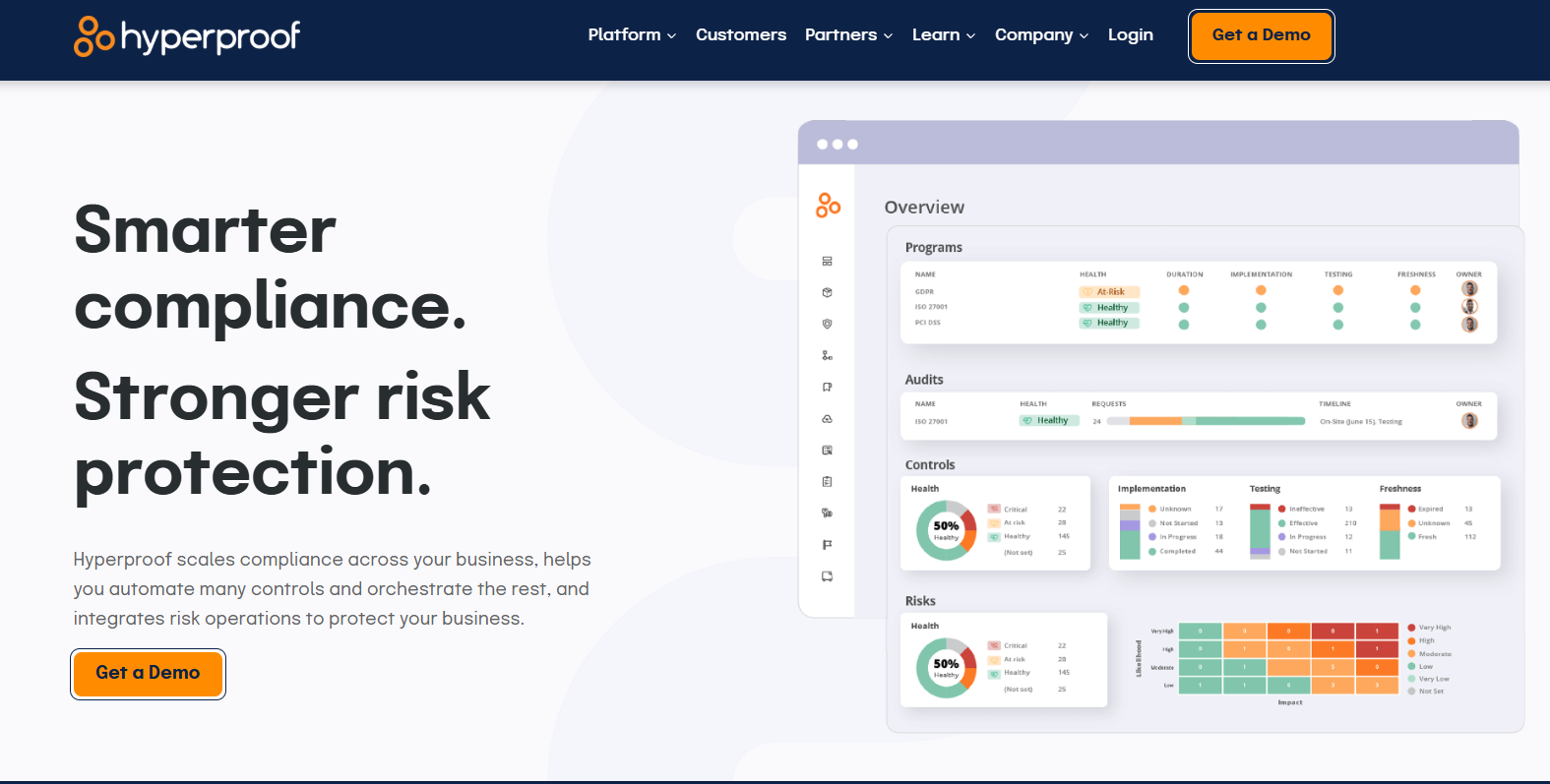
Hyperproof is a comprehensive GRC platform designed to automate and centralize compliance operations.
It offers real-time monitoring, seamless integrations, and a user-friendly interface to help organizations manage and mitigate risks effectively.
Features

- Automated evidence collection from various cloud-based applications, reducing manual effort and ensuring on-time updates.
- Real-time risk monitoring that helps you monitor risks in real-time to drive proactive management and timely mitigation.
- Comprehensive framework support with over 100 out-of-the-box frameworks, including SOC 2, ISO 27001, NIST CSF, and GDPR.
Standout Feature: Automate controls testing and escalation
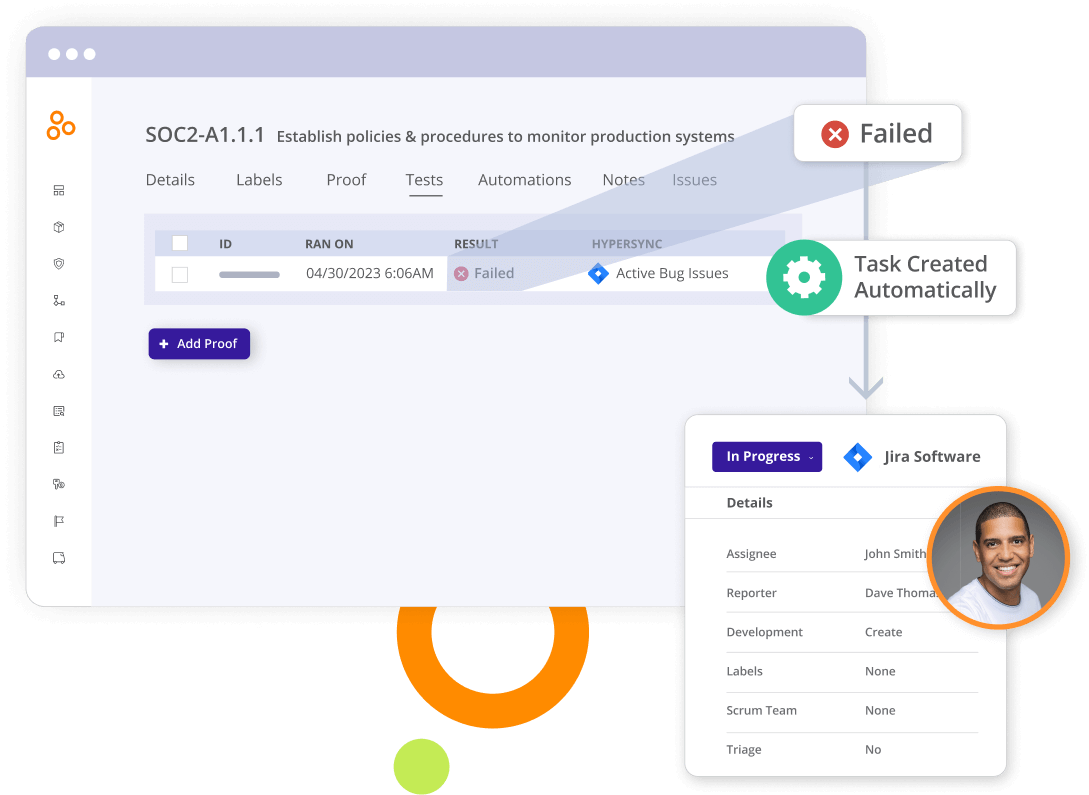
What stood out to me about Hyperproof is that it lets you automatically test and monitor control effectiveness and auto-create tasks based on test status.
Your team will be able to address failed tests immediately to make sure that risks are mitigated and that your controls are always up to date.
Pricing
Hyperproof follows the same trend most GRC platforms do - it provides no public information on its price.
You can book a demo and ask for a custom quote.
➡️ In our in-depth Hyperproof pricing guide, we found that entry-level subscription plans start at $12,000/year, and can go up to $99,700/year.

Pros & Cons
✅ Allows for seamless cross-framework management.
✅ Highly customizable and adaptable, according to users of the platform.
✅ Address failed tests immediately to make sure that risks are mitigated
❌ Has a steep learning curve.
❌ The platform’s pricing can get really expensive for SMEs, which is why some users have been looking for Hyperproof alternatives.
#3: Diligent
Best for: Compliance teams looking for an enterprise-grade GRC solution that brings GRC, audit, ESG, and board management into a single system.
Similar to: Onspring, ArcherIRM.
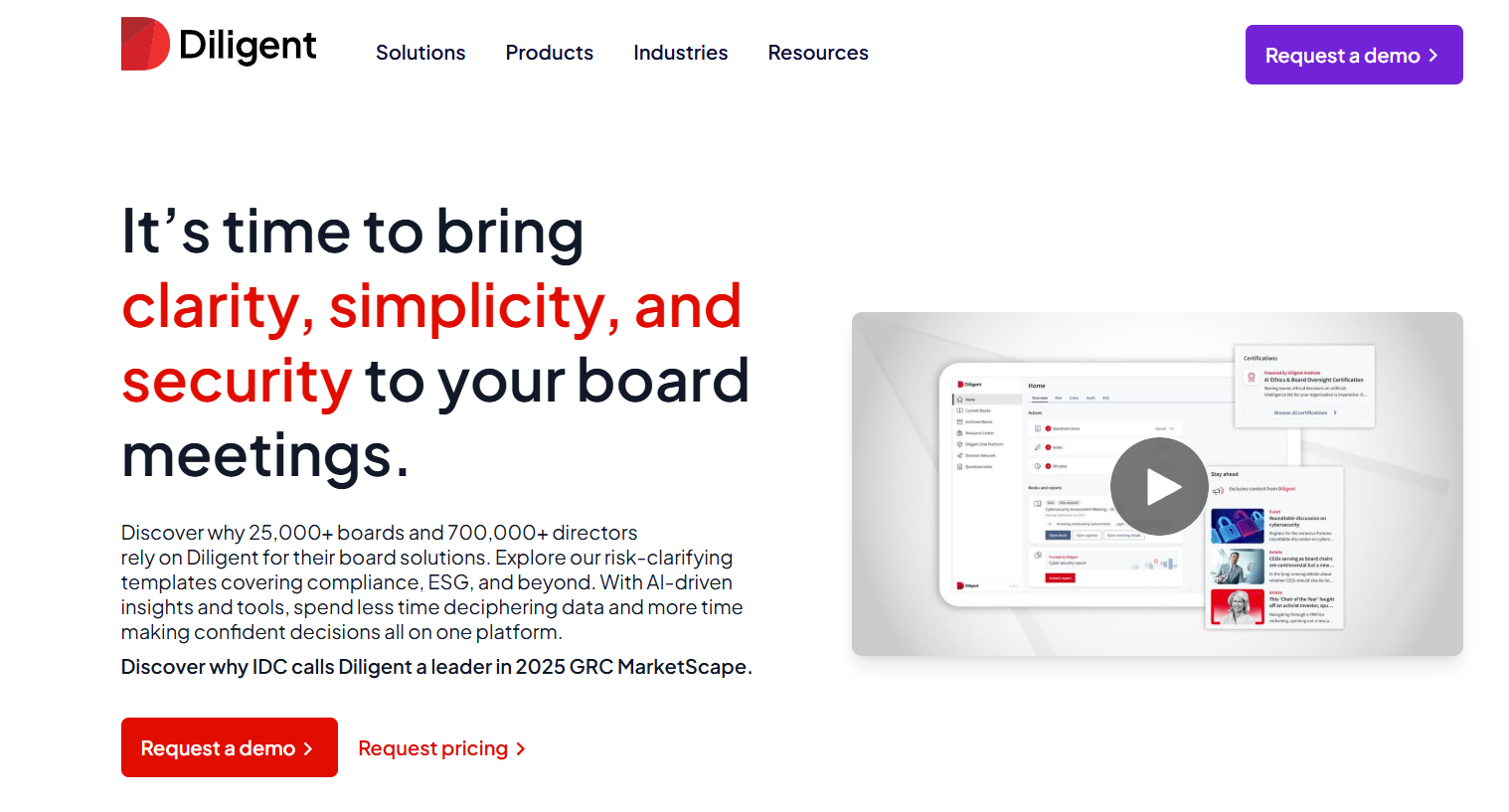
Diligent One provides a comprehensive GRC solution that has been designed for mid-market and enterprise-grade teams.
It’s a proper enough alternative to Drata for teams looking for AI-powered analytics, continuous monitoring, and customizable dashboards.
Features
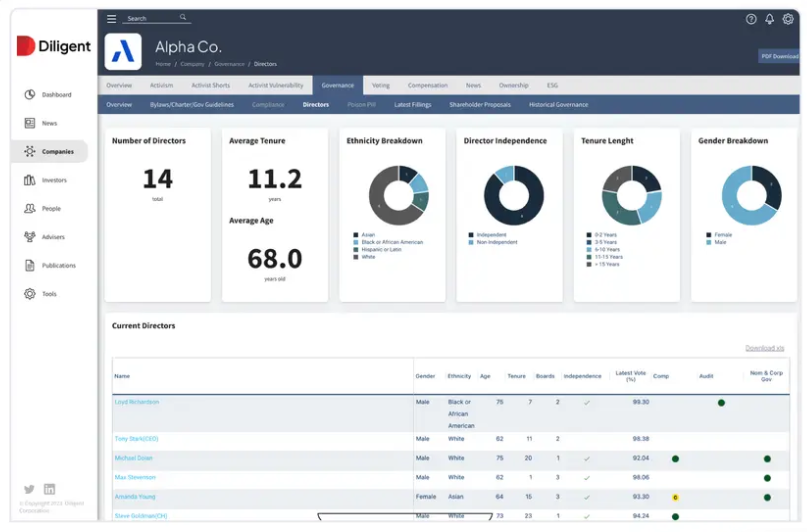
- Built-in reporting & storyboard dashboards that let you select from executive-grade templates and share curated board and committee reports with ease.
- You can configure ongoing data tests and automate business process monitoring (e.g. internal control testing) to detect anomalies and maintain compliance in real-time.
- It’s possible to use scripted tasks in Python or ACL to automate data aggregation, testing, and remediation notifications.
Standout Feature: Diligent AI
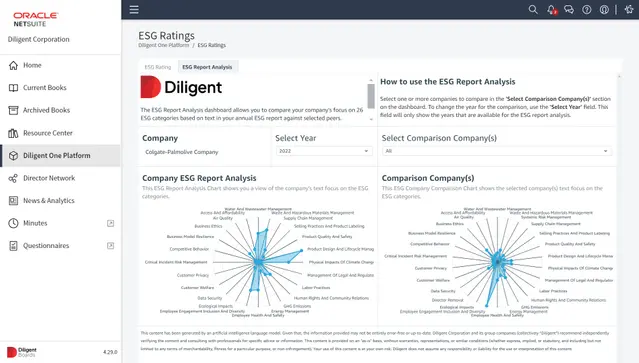
What stood out to me about Diligent is its AI assistant that helps you anticipate risk and stay compliant by generating summaries, mapping out regulatory requirements, and automatically benchmarking ESG and risk in real-time.
Pricing
There’s no official data on Diligent’s pricing plans; however, our team was able to find some reported numbers.
According to 3rd-party data from Vendr, the median buyer of Diligent spends $23,800/year for its solution, with the tool going up to $45,792/year.
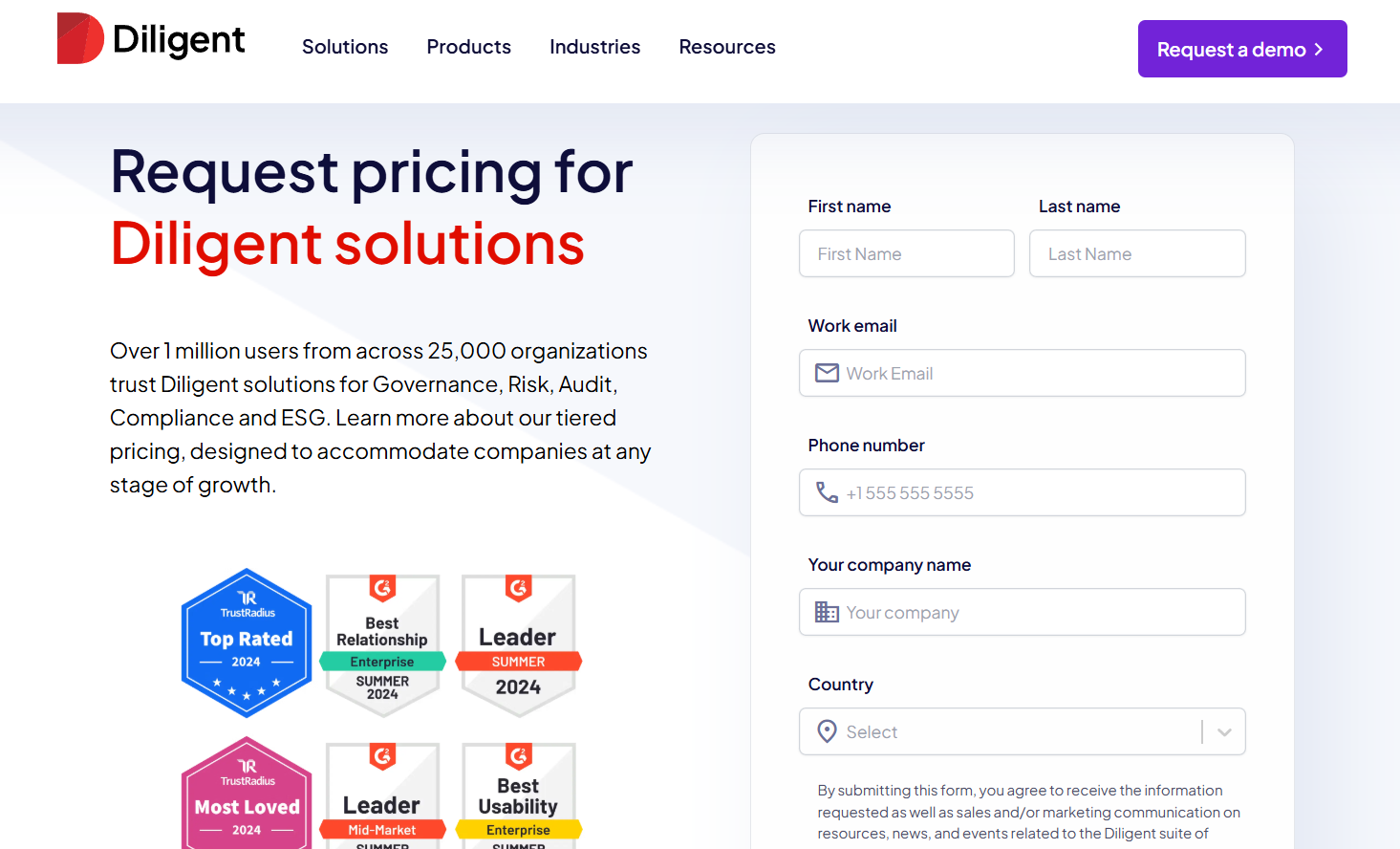
Pros & Cons
✅ One centralized GRC system that aims to replace multiple tools and simplifies oversight across risk and audit workflows.
✅ Integration-rich, allowing you to create seamless workflows between tools.
✅ An AI-powered assistant that can help you boost productivity.
❌ A steep learning curve and long initial setup and onboarding times.
❌ The platform’s pricing can get expensive, similar to Drata, which is why some users have been looking for Diligent alternatives.
#4: LogicGate
Best for: Organizations looking for integrated GRC management with real-time risk insights.
Similar to: ServiceNow GRC.

LogicGate’s GRC platform helps you centralize your GRC processes into a unified framework to automate your workflows and quantify risks.
The platform is a nice Drata alternative for compliance leaders looking to scale while reducing manual effort with the tool’s AI capabilities.
Features

- Real-time risk quantification that lets your team prioritize risks by financial impact and business-criticality.
- Centralized risk repository for visibility across governance, compliance, and third-party risks.
- Out-of-the-box GRC templates that your team can start with to automate compliance reporting, as well as audit trails.
Standout Feature: Spark AI

LogicGate offers AI-powered insights that help your team predict risk and support your decision-making.
➡️ Spark AI also helps you generate executive summaries, which are good for busy CEOs looking for a quick update.
Pricing
Similar to Drata, LogicGate does not publicly disclose its pricing, so you’d have to book a personalized demo with their team to get a quote.
➡️ Take a look at our LogicGate pricing review, where our team found some reported numbers and also discusses whether it has good value for money.

Pros & Cons
✅ AI-driven insights that help you predict risk and support your decision-making.
✅ LogicGate Risk Cloud automates control follow-up tasks.
✅ Customers of the platform appreciate how responsive the customer service team has been.
❌ Some of LogicGate’s customers find the calculation functionality complicated, particularly with labels and percentages.
❌ The reporting features come with limitations, which is why some customers have been looking for LogicGate alternatives.
#5: SAI360
Best for: Enterprises looking to unify risk, compliance, and ethics management into one customizable platform.
Similar to: AuditBoard.

SAI360’s GRC software comes with pre-configured modules and advanced analytics to help you manage risk and ensure regulatory alignment.
The cloud-based platform is a good alternative to Drata for global companies looking to enhance security and streamline workflows with a relatively short implementation time due to its 20+ ready-to-use GRC modules.
Features

- 20+ ready-to-use GRC modules for enterprise risk, IT risk, third-party risk, internal audit, business continuity, policy, and incident management.
- Use AI to improve reporting, risk assessment, and operational efficiency.
- Built-in e-learning so your team can be well-prepared to meet regulatory demands.
- Pre-mapped frameworks and controls aligned with global regulations for faster deployment and easier compliance.
Standout Feature: Integrated GRC from Every Angle

SAI360 offers a holistic, enterprise-wide approach that can help you unify risk, compliance, and ethics management into one customizable system.
Pricing
SAI360 does not currently disclose its pricing, so you’d have to contact them to get a product demo and a quote.
However, we researched SAI360’s pricing and found some reported numbers, so do check out our guide on it.

Pros & Cons
✅ Reporting, risk assessment, and operational efficiency for enterprises.
✅ A holistic approach that helps your team unify risk, compliance, and ethics management.
✅ 20+ ready-to-use GRC modules that your team can get started with without having to set up the platform for months.
❌ The platform is described as outdated and difficult to manage by users, which is why some customers have been looking for SAI360 alternatives.
❌ Admins cannot easily modify fields or workflows, which has made some users upset with the tool.
#6: ArcherIRM
Best for: Global compliance teams looking to track regulatory developments from all over the world.
Similar to: AuditBoard.

ArcherIRM provides large organizations with an integrated risk management solution to help them manage policies, controls, risks, assessments, and deficiencies.
The tool is an enterprise-grade Drata alternative for enterprises looking to streamline compliance management.
Features

- Centralized management of policies, controls, risks, assessments, and deficiencies in one GRC solution.
- Integrated risk management across multiple dimensions, including IT, operational, and third-party risk.
- A customizable platform that adapts to your internal functions and extended third-party ecosystems.
- Consolidate standardized reports, audits, and assessments.
Standout Feature: Archer Evolv

ArcherIRM’s Evolv capability stood out to me as it helps teams track regulatory developments from all over the world.
The software aims to bring visibility to all requirements for better control over policies.
Pricing
ArcherIRM’s pricing structure is not publicly available, so you’d have to contact them to get a product demo and a quote.
Despite this, I was able to find some numbers in our ArcherIRM pricing guide.

Pros & Cons
✅ Real-time cyber risk intelligence capabilities.
✅ Enterprise-grade analytics and real-time reporting.
✅ An AI-powered analytics tool that can be used for predictive risk identification.
❌ An expensive price tag, which starts at approximately $55,000/year, which is why some SMEs have been looking for ArcherIRM alternatives.
❌ The platform seems to have an outdated interface that is not very intuitive, similar to Drata.
#7: AuditBoard
Best for: Companies looking to uncover GRC insights, track trends, and support data-driven decisions.
Similar to: OneTrust, IBM OpenPages.

AuditBoard’s GRC platform helps teams break down silos between audit, risk, and compliance teams to help them build resilience.
The tool is a nice alternative to Drata for companies looking for customizable reports and out-of-the-box dashboards.
Features

- A detailed view of organizational risk that connects your audit, risk, and compliance teams.
- Advanced insights that help you optimize risk and compliance models.
- Customizable reports and pre-built dashboards that can help your compliance team uncover insights, track trends, and support data-driven decisions, covering the weaknesses of Drata.
- Integrated workflows and APIs that help your team streamline data collection and task management through integrations.
Standout Feature: Pre-Built 30+ Frameworks

AuditBoard offers access to its preloaded library of 30+ frameworks (including SOC 2, ISO 27001, and GDPR) to help your organization stay audit-ready.
Pricing
AuditBoard has not yet disclosed its pricing, so you’d have to contact them to book a demo and get a quote.

Pros & Cons
✅ Get access to a single view of organizational risk.
✅ A modern interface with good AI capabilities, covering one of the other weaknesses of Drata.
✅ A preloaded library of 30+ frameworks to help you stay ready for audits.
❌ The average contract value of the tool is around $42,775/year, according to insiders, which is why some people have been looking for AuditBoard alternatives.
❌ Some customers of the platform find it difficult to use.
#8: OneTrust
Best for: Organizations looking to automate compliance and gain enterprise-wide visibility into risk associated with technology.
Similar to: ServiceNow.

OneTrust’s solution simplifies compliance and optimizes the entire risk and compliance lifecycle by helping you automate controls, evidence collection, and reporting.
The GRC software is a solid alternative to Drata for companies looking for pre-built frameworks, extensive integrations, and dynamic dashboards.
Features

- Streamline compliance with the tool’s 55+ ready-to-use frameworks, prescriptive content, and evidence requirements broken down into measurable tasks.
- You can connect compliance teams and departments via automated workflows and 200+ pre-built integrations.
- Map systems, data, and risks in one unified view: Prioritize action with dynamic scoring and strategic impact insights.
- Automatically generate the required controls and evidence tasks.
Standout Feature: Proprietary Shared Evidence Framework

What stood out to me about OneTrust is its functionality to collect evidence once and comply across 50+ frameworks with OneTrust’s shared evidence framework to let you eliminate duplicate data requests.
Pricing
OneTrust has different pricing plans for its 5 product lines, all of which have custom pricing:
- Consent & Preferences: Capture and activate consent, preferences, and first-party data across your user touchpoints.
- Privacy Automation: Simplify compliance, improve operational efficiency, and help your business better use personal data.
- Third-Party Management: Third-party risk management and the ability to fully manage your third-party lifecycle.
- Tech Risk & Compliance: Scale governance, risk, and compliance, and mature your risk program.
- AI Governance: Gain visibility and control over your AI technology and empower risk-based decisions.
➡️ You can review our OneTrust pricing guide, where I go over how much the tool costs.

Pros & Cons
✅ Collect evidence and comply across 50+ frameworks with OneTrust’s shared evidence framework.
✅ An in-depth range of integrations when compared to other competitors in this list, covering for the weakness of Drata.
✅ Monitor and manage your program with dynamic dashboards.
❌ The cost can be a problem for smaller companies, as it’s expensive, which is why some people have been looking for OneTrust alternatives.
❌ The UI has been described as outdated and not user-friendly by G2 reviews, similar to Drata.
#9: IBM OpenPages
Best for: Enterprises looking for an AI-powered GRC platform that integrates various risk and compliance functions.
Similar to: SAI360.

IBM OpenPages offers an AI-powered risk management solution that centralizes siloed risk management functions within a single environment.
The platform is a good enough alternative to Drata as it helps organizations identify, manage, monitor, and report on risk and regulatory compliance.
Features

- Specialized modules for operational risk, regulatory compliance, policy management, IT governance, internal audit, and third-party risk management.
- Utilizes IBM Watson for natural language processing and machine learning (ML) to provide predictive analytics and automate classifications.
- Features a drag-and-drop workflow editor that lets you automate GRC processes to improve time-to-value and reduce manual effort.
Standout Feature: IBM Cognos Analytics (Predictive Insights)

What stood out to me aboutIBM OpenPages are its valuable insights into the state of risk across the organization due to its IBM Cognos Analytics for self-service data exploration.
Pricing
IBM OpenPage’s pricing can be a little confusing to get at first, but there are 4 ways to purchase the solution:
- As a SaaS solution: Essentials Edition starts at $3,300, and the Standard one starts at $6,050.
- As an On-cloud solution: the Single Solution starts at $6,250, and the Enterprise one starts at $9,000.
- As part of IBM Cloud Pak for Data: the Single Solution starts at $162,000, and the Solution Bundle starts at $207,000.
- As On-Premises: You need to contact their team for a quote.

Regardless of which package you opt for in the end, each one will include a core set of IBM OpenPages features, such as its AI features, workflow automation, integrated reports, etc.
Pros & Cons
✅ Scalable architecture that was designed to scale to tens of thousands of users.
✅ Enhances efficiency and accuracy through bespoke AI models and automated processes.
✅ You’ll get access to valuable insights into the state of risk across the organization with its IBM Cognos Analytics.
❌ The tool’s high implementation costs can make it prohibitive for SMEs.
❌ There are reported limited customization options, which is why some users have been looking for IBM OpenPages alternatives.
#10: ServiceNow GRC
Best for: Enterprises looking for integrated risk management and compliance automation.
Similar to: SAI360.

ServiceNow offers a comprehensive GRC solution that provides you with a unified approach to governance, risk, and compliance, integrating data and workflows.
The platform is a good enough alternative to Drata for international teams looking to automate manual processes and deliver AI-driven insights for real-time risk mitigation.
Features

- You can eliminate silos by centralizing enterprise risk and compliance data into one source.
- No-code workflow automation that enables cross-functional risk response and compliance management without having to hire consultants.
- The GRC solution operates on ServiceNow’s Now Platform, which enables seamless data sharing and real-time collaboration across all GRC products.
- Third-party risk management that lets you identify and mitigate risks from external vendors and partners.
➡️ Learn more about ServiceNow in our in-depth ServiceNow review.
Standout Feature: AI-Powered Actionable Insights

ServiceNow stood out to me with its AI-powered actionable insights that help you accelerate decision-making with predictive analytics and process optimization.
Pricing
ServiceNow’s pricing is not currently disclosed, so you’d have to book a demo with their team.
However, we did find ServiceNow customer and public reviews, which show that the average cost of ServiceNow contracts can range between $50,000 and $500,000 annually.
The pricing structure depends on the number of licenses, features, and other configuration requirements.

Pros & Cons
✅ Comprehensive GRC management capabilities.
✅ Real-time risk monitoring and prioritization.
✅ A comprehensive range of native integrations with other tools, covering for the weakness of Drata.
❌ Steep learning curve and complexity, similar to Drata, unlike some ServiceNow alternatives.
❌ Training, skills development, and ongoing support can be costly, unlike some alternatives on the market.
Next Steps: Get Started With SmartSuite & Our Ready-To-Use GRC Templates For Free
That was it from our list of the 10 best Drata alternatives on the market in 2026 for compliance teams looking for a solution.
If your team needs to build governance, risk, and compliance workstreams and effectively prioritize and mitigate risks, give SmartSuite a chance with our free plan and out-of-the-box GRC templates.
SmartSuite’s tool offers just the right customization, native collaboration capabilities and a library of 200+ project management templates to help compliance teams create and maintain a project management workflow.
Here’s what's in it for your team when you try SmartSuite:
- Access to a generous free plan with features including multi-board views (Kanban, Chart, Map, Timeline, Card, and Calendar), 100 automations/month, and 40+ field types, including formula and linked record fields.
- No-code automation builder to set up to 500,000 trigger/action workflows.
- Built-in productivity tools, including time tracking, status tracking, and checklists.
- Team collaboration and planning tools such as whiteboards and SmartSuite docs.
- Resource management across projects and teams.
- 40+ field types, including the option to add your custom fields.
Sign up for a free plan to test the water or get a 14-day free trial to explore all its amazing features.
Or, if you’d like to talk to our team of experts, schedule a demo.
Read More
- 10 ClickUp Alternatives You’ll Love
- Airtable Alternatives: 10 Amazing Tools for Managing Projects Like a Pro
- ServiceNow Pricing: Is It Worth It
- 10 Best Healthcare Project Management Tools
- Top 10 Monday.com Alternatives & Competitors
- Monday.com Pricing: Is It Worth It
- ServiceNow Review: Is It Worth It
- Jira Service Management Pricing: Is It Worth It

Run your entire business on a single platform and stop paying for dozens of apps
- Manage Your Workflows on a Single Platform
- Empower Team Collaboration
- Trusted by 5,000+ Businesses Worldwide















